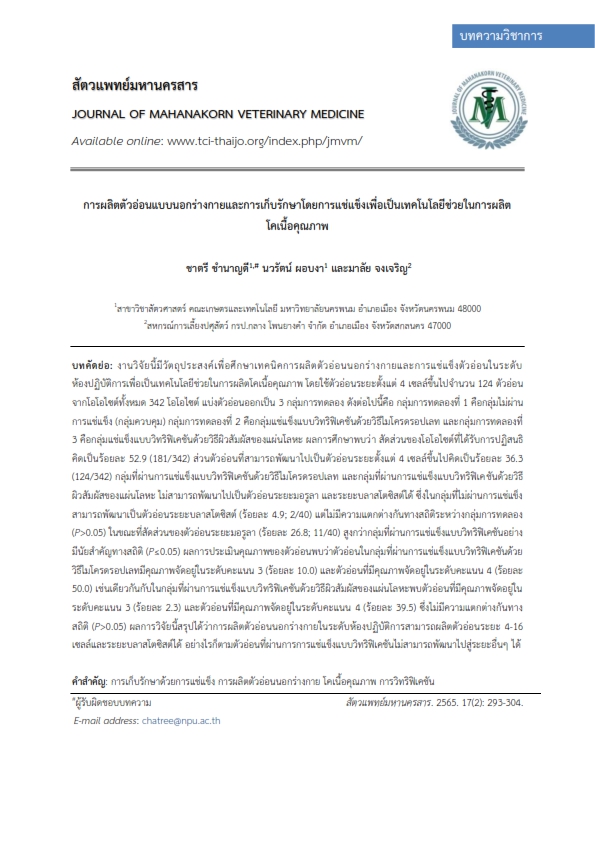In Vitro Production of Embryo and Cryopreservation as the Assistant Technology of Producing Quality Beef Cattle
Main Article Content
Abstract
The objective of this study was to observe the techniques of in vitro embryo production and cryopreservation at the laboratory level as the assistant technology of producing quality beef cattle. A total of 124 embryos with at least 4 cells which developed from 342 cumulus oocyte complexes (COCs) were divided into 3 groups; group 1; non-vitrification (control), group 2; microdroplets vitrification (MDV), and group 3; solid surface vitrification (SSV). The results showed that the proportion of fertilization oocytes was 52.9% (181/342). The proportion of embryos with at least 4 cells was 36.3% (124/342). The vitrified embryos in MDV and SSV groups can not to develop into morula and blastocyst stage. The proportion of blastocyst (4.9%; 2/40) in control group was not different among groups (P>0.05), while proportion of morula (26.8%; 11/40) was significantly higher than those of both vitrified groups (P≤0.05). The embryo quality in MDV group was classified at score 3 (10.0%) and score 4 (50.0%), as well as in SSV group was classified at score 3 (2.3%) and score 4 (39.5%) which not different between vitrified groups (P>0.05). In conclusion, the results showed that in vitro embryo production in our laboratory can produce embryos at 4-16 cells and a few of blastocysts. However, the vitrified embryos cannot develop into other stages.
Article Details

This work is licensed under a Creative Commons Attribution-NonCommercial-NoDerivatives 4.0 International License.
References
Akkoc, T., Taskin, A.C., Caputcu, A.T., Arat, S. and Bagis, H. 2011. The effect of solid surface vitrification (SSV) versus classic vitrification technique on survive rate of in vitro produced bovine blastocysts. J. Anim. Vet. Adv. 10(22): 2885-2891.
Aono A, Nagatomo H, Takuma T, Nonaka R, Ono Y, Wada Y, Abe, Y., Takahashi, M., Watanabe, T. and Kawahara, M. 2013. Dynamics of intracellular phospholipid membrane organization during oocyte maturation and successful vitrification of immature oocytes retrieved by ovum pick-up in cattle. Theriogenology. 79: 1146-1152.
Asami, M., Lam, B.Y.H., Ma, M.K., Rainbow, K., Braun, S., VerMilyea, M.D., Yeo, G.S.H. and Perry, A.C.F. 2022. Human embryonic genome activation initiates at the one-cell stage. Cell Stem Cell. 29: 209–216.
Asgari, V., Hosseini, S.M., Forouzanfar, M., Hajian, M. and Nasr-Esfahani, M.H. 2012. Vitrification of in vitro produced bovine embryos: Effect of embryonic block and developmental kinetics. Cryobiology. 65: 278–283.
Begin, I., Bhatia., B., Blaldassarre, H., Dinnyes, A. and Keefer, C.L. 2003. Cryopreservation of goat oocytes and in vivo derived 2 to 4 cell embryos using the cryoloop (CLV) and solid surface vitrification (SSV) methods. Theriogenology. 59: 1839-1850.
Bo, G.A. and Mapletoft, R.J. 2013. Evaluation and classification of bovine embryos. Anim. Reprod. 10(3): 344-348.
Caamao., J.N., Gomez, E., Trigal, B., Munoz, M., Carrocera, S., Martin, D. and Diez, C. 2015. Survival of vitrified in vitro–produced bovine embryos after a one-step warming in-straw cryoprotectant dilution procedure. Theriogenology. 83: 881–890.
Canon Beltran, K., Cajas, Y.N., Peréz Cerezales, S., Leal, C.L.V., Agirregoitia, Ek., Gutierrez Adán, A., González, E.M. and Rizos, D. 2021. Nobiletin enhances the development and quality of bovine embryos in vitro during two key periods of embryonic genome activation. Sci. Rep. 11: 11796.
Chumnandee, C., Wangsomnuk, P. and Sirisathien, S. 2017. Effects of polyvinyl alcohol on vitrification of mature and immature bovine oocytes. Asia Pac J Sci Technol. 22(4): 1-9.
Department of Livestock Development (DLD). 2012. Beef Cattle Strategy 2012-2016. Ministry of Agriculture and Cooperatives. Bangkok. (In Thai)
Ezoe, K., Yabuuchi, A., Tani, T., Mori, C., Miki, T., Takayama, Y., Beyhan, Z., Kato, Y., Okuno, T., Kobayashi, T. and Kato, K. 2015. Developmental competence of vitrified-warmed bovine oocytes at the germinal-vesicle stage is improved by cyclic adenosine monophosphate modulators during in vitro maturation. Plos One. 10: 1-14.
Faheem, M.S., Baron, E., Carvalhais, I., Chaveiro, A., Pavani, K. and da Silva, F.M. 2014. The effect of vitrification of immature bovine oocytes to the subsequent in vitro development and gene expression. Zygote. 26: 1-10.
Faizah, Z., Darsini, N. and Hinting, A. 2016. Fertilization of bovine oocytes vitrified pre and post in vitro maturation. FMI. 52(2): 104-107.
Food and Agriculture Organization (FAO), 1991. Training manual for embryo transfer in cattle. www.fao.org/docrep/004/t0117e/t0117e00.htm (Accessed 15 September, 2015).
Frei, R.E., Schultz, G.A. and Church, R.B. 1989. Qualitative and quantitative changes in protein synthesis occur at the 8-16 cell stage of embryogenesis in the cow. J. Reprod. Fert. 86: 637-641.
Gupta, M.K., Uhm, S.J. and Lee, H.T. 2007. Cryopreservation of immature and in vitro matured porcine oocytes by solid surface vitrification. Theriogenology. 67: 238-248.
Ishii, T., Tomita, K., Sakakibara, H. and Ohkura, S. 2018. Embryogenesis of vitrified mature bovine oocytes is improved in the presence of multi-layered cumulus cells. J. Reprod. Dev. 64: 95–99.
Malenko, G.P., Kornienko, E.V., Nesterov, I.I. and Kosovsky, G.Y. 2017. A new simple and reliable vitrification device based on Hollow Fiber Vitrification (HFV) method evaluated using IVP bovine embryos. Anim. Reprod. 14(2): 392-399.
Montagner, M.M., Gonçalves, P.B.D., Mills, G.A., Christenson, R.K. and White, B.R. 2006. Freezing swine embryos: do success rates differ between breeds? Nebraska Swine Rep. 21-25.
Office of Agricultural Economics. 2016. Situation of important agricultural products and trends in 2017. Agricultural Information Center Office of Agricultural Economics. Ministry of Agriculture and Cooperatives. Bangkok. 241 p. (In Thai)
Papis, K., Shimizu, M. and Izaike, Y. 2000. Factors affecting the survivability of bovine oocytes vitrified in droplets. Theriogenology. 54: 651-658
Rall, W.F. and Fahy, M. 1985. Ice-free cryopreservation of mouse embryos at -196 ◦C by vitrification. Nature. 313: 573–575.
Vajta, G. and Kuwayama, M. 2006. Improving cryopreservation systems. Theriogenology. 65: 236–244.
Van den Abbeel, E. and Van Steirteghem, A. 2000. Zona pellucida damage to human embryos after cryopreservation and consequences for their blastomere survival and in vitro viability. Hum. Reprod. 15(2): 373-378.
Woods, E.J., Benson, J.D., Agca, Y. and Critser, J.K. 2004. Fundamental cryobiology of reproductive cells and tissues. Cryobiology. 48: 146-156.


